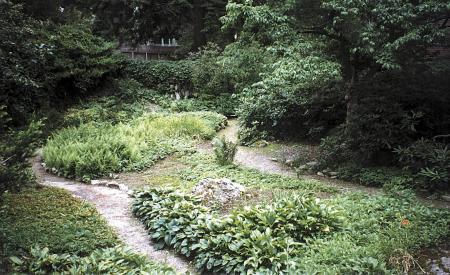By Wendy Shearer
 |
|
| A garden that connects with our senses through water seems more exciting, complete and memorable. |
Texture is by definition a quality of the surface of a material. Colour, hardiness and overall size are of secondary importance to the visual character of the material. As a result, texture is best appreciated through direct tactile experience. The growing popularity of moss gardens is a clear indication of the gardener's appreciation of fine textures, especially when coupled with natural stone or water.
Texture invites the garden visitor to touch as well as look. The irresistible velvet leaves of stachys, the satin bark of white birch, and the cat's tongue roughness of cord grass are all examples of contrasting textures, which can be directly experienced. The successful garden designer places a variety of these tactile surfaces close to walkways and seating areas to maximize the touching opportunities for the visitor.
The garden designer must also be aware of the texture of a material throughout different seasons. For example, the fine soft foliage of artemesia, which is most evident in spring and summer, is invisible in winter. The successful designer will compensate for this seasonal variation in the overall garden plan. Feature areas will be highlighted in different parts of the garden throughout each season. The designer thinks of the garden as a theatre stage, where a spotlight moves to follow and highlight the dramatic action.
 |
Texture relies on contrast for effect. Placing fine and coarse textured materials close to each other enhances the visual qualities of each. The climbing hydrangea on a brick wall in winter has a strong dramatic effect because the distinctive rustic bark contrasts with the smoother surface of the brick.
Texture may be further enhanced by using light and shadow to the designer's advantage. For example, the same foliage combinations that give a uniform texture to a planting bed during the day can be transformed into a dramatic backdrop with the addition of decorative accent lighting. Landscape lighting should be limited to one light per feature and if possible, be set at an oblique angle to the object to increase the perception of the depth of the object.
The easiest way to assess the amount of contrast in the texture of the garden is to imagine a black and white photo of the area. The removal of colour helps to focus attention on the size and shape of the foliage and woody components beyond the appeal of their overall form and colour.
Plant textures to consider when planning a garden
The following plants will provide a range of textural qualities in any landscape.
| Texture | Example |
| Velvety | Stachys (lamb's ears), Lychnis (campion) |
| Smooth | Sempervivum (hen and chicks), Mahonia (grape holly) |
| Fine | Chamaecyparis (false-cypress), Pinus strobus (white pine) |
| Rough | Hydrangea (oak-leaved or climbing), Euonymus alata (burning bush) |
| Rugged | Yucca (Adam's needle), Stipa (cord grass) |
| Quilted | Hosta sieboldiana, Hamamelis virginiana (witch hazel) |
| Coarse | Ricinus communis (castor bean plant), Catalpa (umbrella tree), Acanthus (bear's breeches) |
Different hard and soft textures, when combined imaginatively and judiciously, will transform an ordinary landscape into a much-appreciated thing of beauty.
Wendy Shearer, OALA, CSLA, ASLA, is principal in the firm Wendy Shearer Landscape Architect Limited, established in 1984. The award-winning firm provides design services to a wide range of corporate, municipal and institutional clients from its office in Guelph, Ontario.